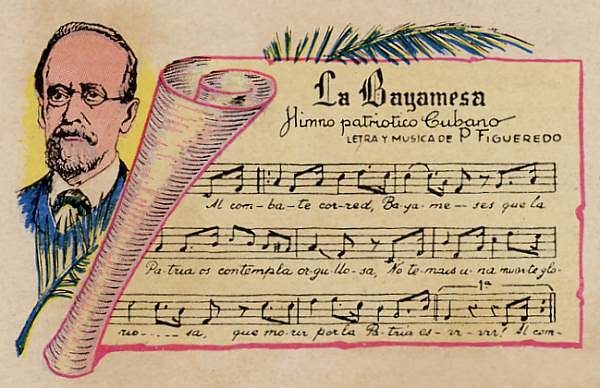8.6 National Anthem of Cuba.

October 20th is a date of great significance in the history of the Cuban nation, and as such, it has become a symbol, a historical value, and a historical and cultural tradition. Tradition tells that Perucho Figueredo, without dismounting his warhorse and leaning on the saddle, wrote the verses of the poem that provided lyrics for a march, thus creating the CUBAN NATIONAL ANTHEM. Since then, this anthem has transcended and has been present in the lives of the Cuban people.
On August 13, 1867, Pedro “Perucho” Figueredo Cisneros, Francisco Vicente Aguilera and Francisco Maceo Osorio were meeting when the latter suggested to Perucho: “You could say that we are now meeting as a War Committee… now it’s your turn to compose our “Marseillaise”.
By dawn the next day, the verses of the Cuban national anthem had already been written, and almost a year later, Manuel Muñoz, director of a city orchestra, set them to music. On June 11, 1868, during the traditional Te Deum and Corpus Christi procession (religious festivities), held in the parish of San Salvador de Bayamo, the music composed for the verses written by Perucho was first heard. This was made possible by Father Diego José Baptista’s support for Cuban independence.
It was a great challenge because the entire Bayamo society converged there, both the independence fighters and the colonialists. Lieutenant Colonel Julián de Udaeta, the military commander of Bayamo, realized the audacity and sent for Pedro Figueredo for questioning. The arguments presented didn’t satisfy the Spanish soldier, who declared: “You’re right: I’m not a musician, but rest assured that you didn’t deceive me. You can retire with that certainty.”
On October 20, 1868, Bayamo became the first city in Cuba freed from Spanish rule. Amid the joy of the victory, Perucho Figueredo appeared. There, the crowd hummed the music they’d known since June and began to ask for the lyrics. The patriot took a pencil and paper from his pocket and, from his horse, played the lyrics he knew by heart. The people began to sing, and Lieutenant Colonel Udaeta, upon hearing it, declared: “I wasn’t fooled. It’s war music!”
Perucho published the anthem in the newspaper El Cubano Libre under the name La Bayamesa, Himno patrótico (The Patriotic Anthem), on October 27, 1868. The inclusion of the Cuban name denotes the march’s reach; by this date, the Cuban people had adopted it as their national anthem.
On November 8, 1868, at 10 a.m., Carlos Manuel de Céspedes, at the door of the Main Church, heard the hymn sung by a choir of 12 Bayamesas: six white and six black.
Lyrics of the Cuban National Anthem:
Run to battle, Bayamo people
that the Homeland looks at you proudly
Do not fear a glorious death
that to die for the Fatherland is to live.
In chain, living is living
plunged into shame and disgrace,
listen to the sound of the clarion
To arms, brave men, run.








